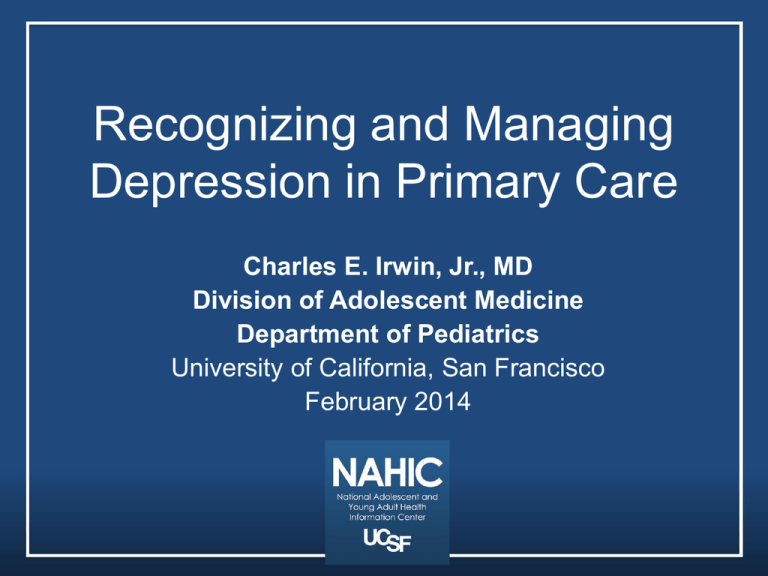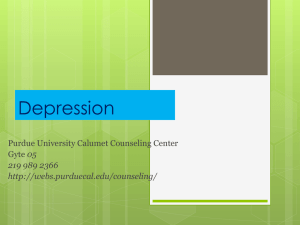
Recognizing and Managing
Depression in Primary Care
Charles E. Irwin, Jr., MD
Division of Adolescent Medicine
Department of Pediatrics
University of California, San Francisco
February 2014
USPSTF Recommendation
• Screening of adolescents (12-18 yrs) for
major depressive disorder (MDD) when
systems are in place to ensure accurate
diagnosis, psychotherapy (CBT or
interpersonal) and follow up.
– March 2009
http://www.ahrq.gov/clinic/uspstf09/depress
ion/chdeprrs.htm
Outline
• General Overview
• How to Make the Diagnosis
– Hx taking
– Physical exam
– Screening Instruments
• Epidemiology
• Management
Major Depressive Disorder
• Primary care clinicians say of the teens
they see:
- 9-21% have MDD
• Impact school performance
• Substance use/abuse
• Associated with increased risk of
suicidal behavior
Possible Symptoms of MDD
•
•
•
•
•
•
•
•
•
Appetite disturbance
Sleep disturbance
Fatigue or loss of energy
Cardiopulmonary symptoms
GI symptoms
Neuromuscular symptoms
Gynecological symptoms
Dermatological symptoms
Behavioral symptoms
History and Physical Exam
• Patient history
– HEADSSS
• Family history (may need to ask parents
separately)
• Complete physical exam
• BMI
• Neuro exam
• Consider labs
HEEADSSS
Home
Education/Employment
Eating
Activities
Drugs
Sex
Suicide/Safety
Strengths
SIGECAPS
looks for criteria for Major Depressive Disorder
S
I
G
E
C
A
P
S
- Sleep disturbance: insomnia or hypersomnia
- Interest or pleasure: diminished in almost all
activities
- Guilt: feelings of excessive worthlessness or
guilt
- Energy: fatigue or energy loss nearly every day
- Concentration: diminished.
- Appetite: weight loss or decreased appetite
- Psychomotor agitation or retardation
- Suicide: recurrent thoughts of death or suicidal
ideation
Screening Instruments
• PHQ-A
– Patient Health Questionnaire for
Adolescents
• BDI – PC
– Beck Depression Inventory – Primary
Care
Symptoms and Criteria for a Major
Depressive Episode
• Depressed mood or loss of interest or pleasure for a 2-week
period (or irritability among children and adolescents), plus:
• Four or more of the following symptoms in the same 2-week
period:
–
–
–
–
–
–
–
Significant weight loss (when not dieting) or weight gain
Insomnia or hypersomnia nearly every day
Being restless or being slow (psychomotor agitation or retardation)
Fatigue or loss of energy nearly every day
Feelings of worthlessness or excessive or inappropriate guilt
Inability to concentrate
Recurrent thoughts of death or suicide ideations or plans
DSM V
Symptoms in Adolescents
DSM-IV sx of MDD
As seen in teens
Depressed mood most of the day
Irritable or cranky mood
Loss of interest in once favorite
activities
Loss of interest in sports, video
games, activities with friends
Weight loss/gain
Somatic complaints, failure to gain wt
Insomnia/hypersomnia
Excess late night TV, refusal to wake
for school
Psychomotor agitation/retardation
Talk of running away from home
Fatigue, loss of energy
Persistent boredom
Decreased concentration,
indecisive
Poor school performance, frequent
absences
Loss of self esteem, guilt
Oppositional/negative behavior
Depressive Symptoms in Teens
• More sleep and appetite disturbances,
delusions, suicidal ideation and
attempts, and impairment of
functioning than younger children with
MDD
• More behavioral problems and fewer
neurovegetative symptoms than adults
with MDD
Differential Diagnosis
of Depression
• Anemia
• Mononucleosis
• Hypothyroidism
• Hyperthyroidism
• Inflammatory bowel disease
• Collagen vascular disease
Major Depression &
Co-morbidity
• 76% with major depression also had other
diagnoses, two thirds of which preceded
the depression diagnosis.
• Previous diagnoses among the 76%
include:
– Anxiety disorders (40%)
– Conduct disorders (25%)
– Addictive disorders (12%)
Source: Kessler, 1998
Symptoms of Bipolar disorder in
Adolescence:
• Markedly labile
mood
• Reckless behaviors
• Agitated behavior
• Spending sprees
• Pressured speech
• Racing thoughts
• Sleep disturbances
• Illicit activities
• Psychotic symptoms
such as
hallucinations,
delusions, irrational
thoughts
Risk factors for Depression
• Genetics
– 20% have + family hx; female gender
• Biology
– puberty, premenstrual, postpartum
• Environment
– Family conflict, substance use at home
• Negative life events
– Divorce, loss of parent
• Individual factors
– Poor self esteem, poor school performance
• Co morbidities
– Mental health
– Chronic medical conditions
Epidemiology of Depression
• Prevalence of MDD in children (< 13
y.o.) is 2.8%, with 1:1 ratio of girls to
boys
• In adolescence (13-18 y.o.), prevalence
is 5.6%, with a higher prevalence for
girls than boys (5.9% vs. 4.6%)
• Lifetime prevalence among adolescents
is 20%.
SOURCE???
Depression: Broad Measure
Sadness or Hopelessness which Prevented Usual Activities by Gender
and Race/Ethnicity, High School Students, 2007
42.3 %
34.6 %
35.8 %
34.5 %
30.4 %
24.0 %
17.8 %
Source: Grunbaum et al., 2008; YRBS; Self-report
21.2 %
Depression: Broad Measure
Sadness or Hopelessness which Prevented Usual Activities by Gender
and Race/Ethnicity, High School Students, 2011
Source: Grunbaum et al., 2008; YRBS; Self-report
Suicide: Seriously Considered
Gender and Race/Ethnicity, High School Students, 2008
21.1 %
18.7 %
17.8 %
18.0 %
10.7 %
10.2 %
8.5 %
Source: Grunbaum et al., 2008; YRBS; Self-report
10.3 %
Epidemiology of Depression
• At any given time, up to one in 13
adolescents have major depression
making it more common than asthma
• Each successive generation since
1940 is at greater risk of developing
depression, and is identified at a
younger age
Prognosis
• 70% of youth with a major depressive
episode will have another episode in next
5 years
• Youth with depression have a 4x increased
risk of an adult depressive disorder
• 20-40% of children with major depression
will develop bipolar disorder eventually
• Can lead to impaired functioning in
relationships, school etc…
Principles of Treatment
• Ensure safety
• Develop an alliance with the teen and parents
– Confidentiality?
• Psycho-education
– Addresses signs and symptoms of
depression
– Stresses importance of psychotherapy and
psychiatric medications
– Addresses misconceptions
Indications for PCP Care vs. Specialist in
Adolescents with Depression
Indications for PCP
• Initial episode of
depression
• Absence of coexisting
conditions
• Ability to make a no
suicide contract
Indications for Specialist
• Chronic, recurrent
depression
• Lack of response to initial
treatment
• Coexisting substance abuse
• Recent suicide attempt or
current suicidal ideation
• Psychosis
• Bipolar
• High level of family discord
• Inability of family to monitor
patient’s safety
Depression-Treatment Options
• Cognitive Behavioral Therapy (CBT
• Interpersonal therapy
• Pharmacotherapy
– First line therapy, SSRI’s
– Others– SNRI’s, Buproprion, TCA’s,
• Combinations of the above methods
works best
• Family therapy
ABCs of CBT
You cannot
control how
you feel, but
you can
control what
you think
about, and this
can influence
how you feel
Cognitive Behavioral Therapy
• Treatment targets patient’s thoughts and
behaviors to improve mood
• Essential elements of CBT include:
– increasing pleasurable activities
– reducing negative thoughts
– and improving assertiveness and problemsolving skills to reduce feelings of
helplessness.
Interpersonal Therapy for
Depression
• Interpersonal problems may cause or
exacerbate depression and that
depression, in turn, may exacerbate
interpersonal problems.
• Treatment will target patients
interpersonal problems to improve both
interpersonal functioning and his/her
mood.
Pharmacological Treatment
• Selective Serotonin Reuptake
Inhibitors (SSRIs) are first line for
medication for adolescents for
depression and anxiety
• Fluoxetine, only drug approved for
treatment of MDD among youth.
What is a “Black Box Warning?”
• It is a required statement on the
package insert that accompanies every
prescription
• It is the strongest warning from the FDA
to prescribers and patients regarding
possible adverse effects of a medication
• HOWEVER, it is not a contraindication
for use of a medication
Black Box Warning
• FDA put on all antidepressants in
2004.
• “..increase the risk of suicidal
thinking and behavior (suicidality) in
children and adolescents with major
depressive disorder (MDD) or other
psychiatric disorders.”
• Rx with SSRI’s leads to 1-2%
absolute increase in risk of suicidality
If starting an antidepressant
• Confirm your diagnosis
– BDI, PHQ-A
• Start low and advance slowly
• Follow up frequently-the black box warning
recommends weekly for the first 4 weeks and
when a dosage change is made
• If no improvement after 6 weeks consider
changing meds and reconfirm diagnosis
• If the patient has a family member who has had a
good response to a particular SSRI, that may be
helpful in selecting a medication.
Talking Points to Patients and
Families about SSRI’s
• Need to supervise medication administration;
• If your child has threatened or attempted
suicide, keep medication in a secure location.
• Likely duration of medication treatment 6
months to 1 year after symptoms improve and
sometimes longer
• Medication should be stopped gradually under
doctor’s supervision, due to the possibility of
withdrawal symptoms
SSRI’s Side Effects
•
•
•
•
Nausea
Loss of appetite
GI upset
Minimal weight
loss
• Headache
• Agitation
• Akasthesia
• Sexual dysfunction
• Increased clotting
time
• Hypomania or
mania
• Sedation or
insomnia
• Vivid dreams
Questions at Follow Up
• Missed doses
• Stomachaches/Headaches
• Restlessness
• Unsettled thoughts
• Suicidal thoughts
• Positive effects
Initial Strategies
• Know the resources in your
community
• Education for patients and families
• No suicide contracts
• Removing firearms, medications,
sharp objects from where they are
accessible.
Summary
• Major burden – disabling condition
• Hx taking/Screening tests are effective in
making dx of MDD
• Effective treatment leads to decrease in
symptoms & improved functioning
• Harm from treatment – minimal
References
Centers for Disease Control and Prevention (CDC), Youth Risk Behavioral Surveillance System, U.S. 2007, MMWR, June 6, 2008/
Volume 7/ Number SS-4, http://www.cdc.gov/HealthyYouth/yrbs/pdf/yrbss07_mmwr.pdf , Accessed 05/01/09.
Goldenring JM, Rosen DS. Getting into adolescent heads: An essential update. Contemporary Pediatrics 2004;21:64-90
Graber JA, Sontag LM. Internalizing Problems during Adolescence. In: Lerner RM, Steinberg L, eds. Handbook of Adolescent
Psychology, 3rd edition. Hoboken, NJ: Wiley, 2009
Hagan JF, Shaw JS and Duncan PM (eds.). Bright Futures, 3rd Edition. Vol. Hagan JF, Shaw JS, Duncan PM (eds) Bright Futures,
3rd Edition, Elk Grove Village, IL: American Academy of Pediatrics, 2008. Elk Grove Village, IL: American Academy of
Pediatrics, 2008
Kessler RC, Walters EE. Epidemiology of DSM-III-R major depression and minor depression among adolescents and young adults
in the National Comorbidity Survey. Depress Anxiety 1998;7:3-14
Lock J, Walker LR, Rickert VI and Katzman DK. Suicidality in adolescents being treated with antidepressant medications and the
black box label: position paper of the Society for Adolescent Medicine. J Adolesc Health 2005;36:92-3
March J, Silva S, Petrycki S, et al. Fluoxetine, cognitive-behavioral therapy, and their combination for adolescents with depression:
Treatment for Adolescents With Depression Study (TADS) randomized controlled trial. JAMA 2004;292:807-20
March JS, Silva S, Petrycki S, et al. The Treatment for Adolescents With Depression Study (TADS): long-term effectiveness and
safety outcomes. Arch Gen Psychiatry 2007;64:1132-43
Melvin GA, Tonge BJ, King NJ, Heyne D, Gordon MS and Klimkeit E. A comparison of cognitive-behavioral therapy, sertraline, and
their combination for adolescent depression. J Am Acad Child Adolesc Psychiatry 2006;45:1151-61
Sharp LK, Lipsky MS. Screening for depression across the lifespan: a review of measures for use in primary care settings. Am Fam
Physician 2002;66:1001-8
Stein RE, Zitner LE and Jensen PS. Interventions for adolescent depression in primary care. Pediatrics 2006;118:669-82
U.S Preventive Services Task Force (USPSTF). Screening and Treatment for Major Depressive Disorder (MDD) in Children and
Adolescents. U.S Department of Health And Human Services, Agency for Health Care Research and Quality, March 2009,
http://www.ahrq.gov/clinic/uspstf09/depression/chdeprrs.htm, Accessed 05/01/09.
Williams SB, O'Connor EA, Eder M and Whitlock EP. Screening for child and adolescent depression in primary care settings: a
systematic evidence review for the US Preventive Services Task Force. Pediatrics 2009;123:e716-35
Zuckerbrot RA, Jensen PS. Improving recognition of adolescent depression in primary care. Arch Pediatr Adolesc Med
2006;160:694-704








